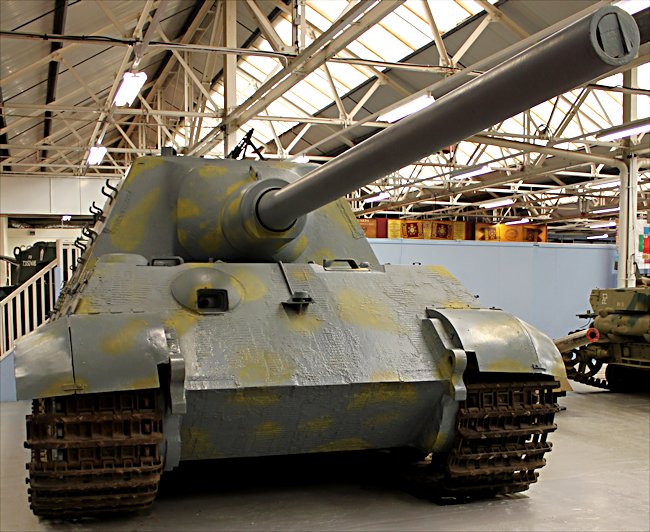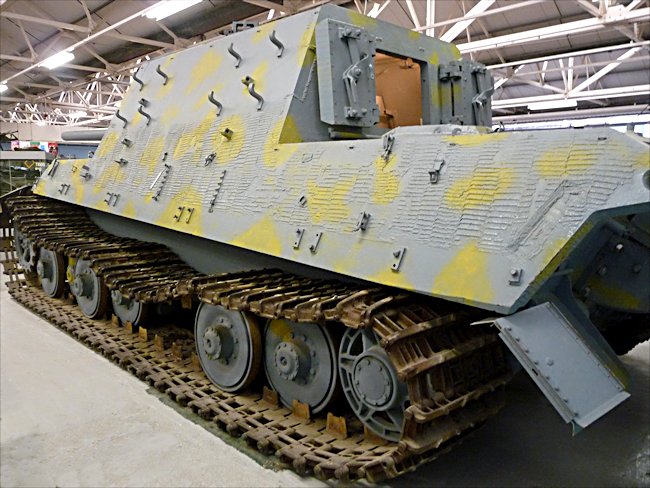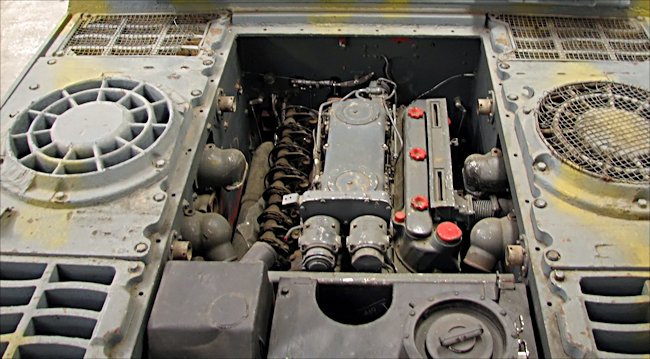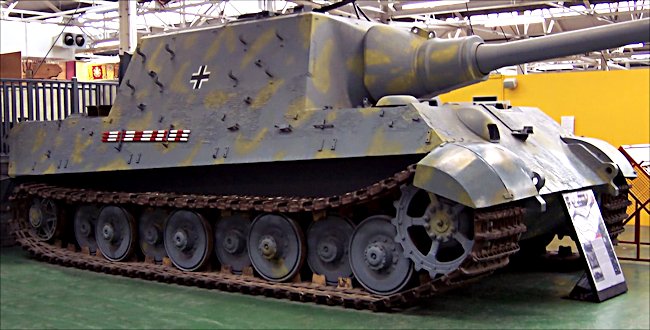The Jagdtiger Tank Destroyer
This preserved German Jagdtiger Tank Destroyer (hunting tiger) can be found at the Bovington Tank Museum, Dorset, England. They were also known as Panzerjäger (tank hunter) Tiger.

Preserved German Jagdtiger Tank Destroyer. From this angle you can see the Panther tank influence.
Unlike the other surviving Jagdtigers this has a the Porsche running gear (8 road wheels), Fahrgestell number 305004. It was captured by the British in the Henschel proving grounds at Haustenbeck, Germany in April 1945. The third wheel station on the left side is missing. The anti-magnetic mine paste called Zimmerit was applied to approximately 2 meters high on the superstructure and the black and white Wehrmacht Balkenkreuz German Armed Forces Cross was painted in the mid section.
In January 1944 Ferdinand Porsche presented the German High Command with some completed alternative chassis to the Henschel Tiger Tank chassis. Once again there was a competition between the Henschel and Porsche Factory designs as there had been for the Tiger 1 tank.
Only the first eleven Jagdtigers were built on the Porsche chassis the others all used Henschel tank chassis . The Jagdtiger at Bovington Tank Museum is the only surviving example of those first eleven Porsche super heavy tank destroyers. It was the second one to come off the production line. It was captured by British troops in April 1945 near Sennelager in Germany where it was being used for trials.
The Henschel version of the Jagdtiger had the over lapping double road wheels as seen on the Tiger I and Tiger II tanks. The Porsche chassis had fewer (8) slightly smaller road wheels which made maintenance easier. The Henschel tank suspension system had 9 larger road wheels.
The other three surviving Jagdtigers, the one in Kubinka, Russia and the two in America are all examples of Jagdtigers built on the Henschel chassis. The total production run was only 85 vehicles.

Slopping side armour and rear crew hatch of a Jagdtiger Tank Destroyer. You can see the Zimmerit anti-magnetic mine paste on the side.
Four Jagdtigers stopped Patton in December 1944
American Major Al Irzyk of General Patton’s 3rd Army, 4th Armoured Division was ordered to drive his M4 Sherman tanks through the night and go to the rescue of the besieged American troops in the city of Bastogne. On 16th December 1944 the newly formed German 6th Army started a new offensive aimed at capturing the port of Antwerp. They made a surprise attack through the Ardennes and soon surrounded the strategically important Belgium city of Bastogne on 19th December 1944.
The winter weather was bad. Snow and ice roads hindered the Americans. They drove through following day and night to reach the Bastogne area. Thirty two tanks of the 8th battalion reached the outskirts of the city within 24 hours of receiving their orders to move off. The Germans had blown a bridge which delayed the advance as they had to clear the surrounding woods before the engineers could construct a temporary pontoon bridge for the tanks to cross.
On the morning of 23rd December 1944, blocking their way into Bastogne was the defended village of Chaumont. They were fired upon as they approached it at first light. Major Al Irzyk devised a pincer movement plan of attack, C Company would circle around to the left, A company would circle around to the right whilst he would lead B Company on a frontal assault of the village. He recalls, "Now if I was at Fort Knox, Kentucky taking a tactics course I probably would have gotten an ‘A’ grade for my plan. As you know in combat there are the imponderables of the battlefield."

Engine compartment at the rear of a Jagdtiger Tank Destroyer
"C company reports to me that five of its tanks in its first platoon were completely bogged down. This ground was supposed to be frozen so right away I knew C Company was going to be of no help. So B Company started to advance down onto the town. We were hitting resistance but it was not major resistance. Armoured infantry were working with us. When we got down into town they would go down to the buildings or into them where the German soldiers were. B Company gets through the town and then the heavens open up. All hell breaks loose. We are suddenly hit all at once by direct fire. Now it is a matter of survival. I cannot describe the chaos that was there."

Side view of a Jagdtiger Tank Destroyer
Major Albert Irzyk and his tanks had driven into a carefully planned ambush. "It was a platoon of four Jagdtigers. Bang, bang, bang all over the place. Tanks in front of me had been hit. B Company was downtown and you cannot turn because of the narrow streets so we are very vulnerable. I told my driver to start backing up. Now he was backing up blind. He needs some help from me. To move back out I had the turret turned to face backwards so I could direct the driver but this exposed the back of our turret to the enemy which made it very vulnerable. I began to breathe a bit easier when it seemed we were out of range. When suddenly I heard this loud screeching sound just for an instant. The whole tank was pushed forward as if a sledge hammer had hit it."
"A 128mm shell, which should have breezed through the turret like a hot knife through butter, must have hit and bounced off. I shouted at the driver, ‘keep going’. As we were moving back I noticed there was a seam in the tank turret with daylight showing through it so I knew something had hit the turret. We finally pulled the tank out of range. I asked myself the question. Why are we still here? Why did my tank survive this battle when it had had this terrible terrible blow? Next to the antenna well there was an appendage. The Jagdtiger’s 128mm shell hit it and was deflected. It was an absolute miracle that I survived that battle."
At the battle of Chaumont the Americans loose eighteen tanks to the Jagdtiger’s mighty 128mm PaK 44L/55 main gun. They stall the advance of the rescue attempt by General Patton’s armour.
Where can I find other preserved Jagdtigers?
- Tank Museum in Kubinka, Russia (captured Battle of Kursk)
- Ordnance Museum, VA, USA (captured Anzio, Italy)
- National Armor and Cavalry Museum, Fort Benning, GA, USA
- Source - Pierre-Oliver Buan - http://the.shadock.free.fr/Surviving_Panzers.html
WW2 tank books

